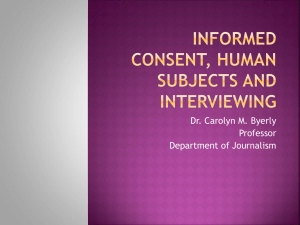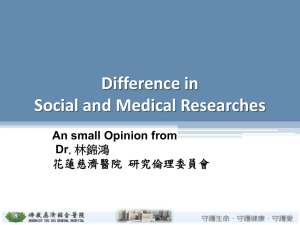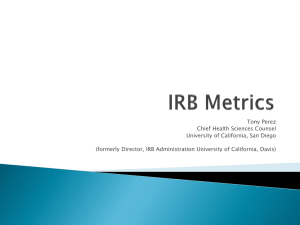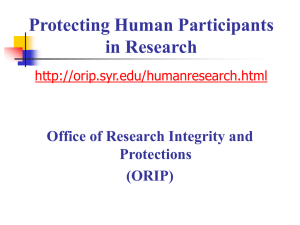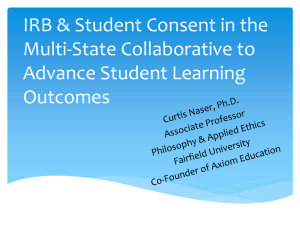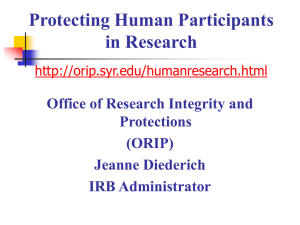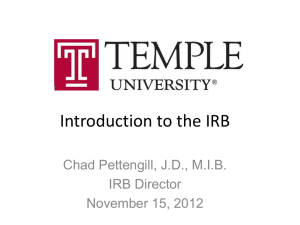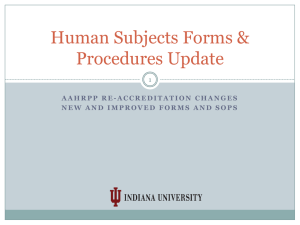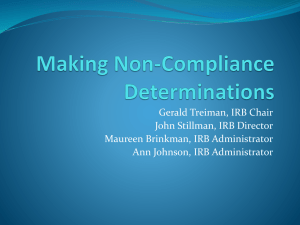Institutional Review Board Nuts and Bolts of CGU IRB Procedures
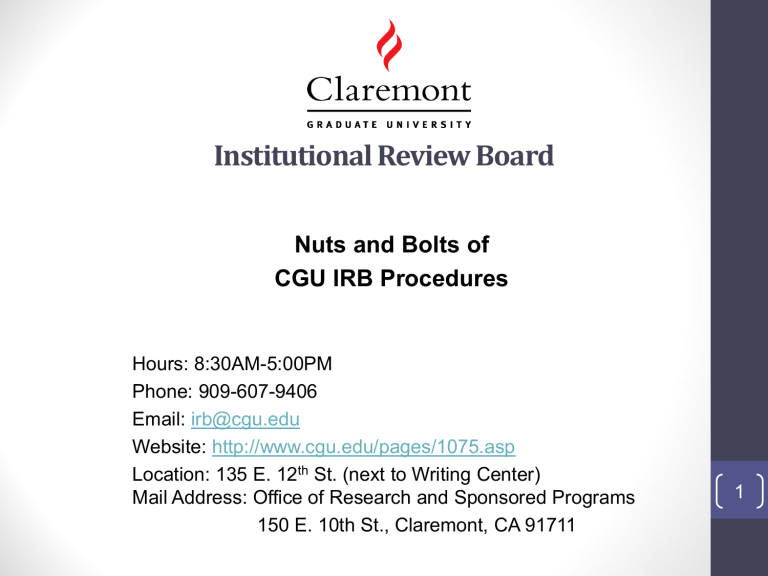
Institutional Review Board
Nuts and Bolts of
CGU IRB Procedures
Hours: 8:30AM-5:00PM
Phone: 909-607-9406
Email: irb@cgu.edu
Website: http://www.cgu.edu/pages/1075.asp
Location: 135 E. 12 th St. (next to Writing Center)
Mail Address: Office of Research and Sponsored Programs
150 E. 10th St., Claremont, CA 91711
1
What is the IRB?
• IRB = Institutional Review Board
• Tasked with assuring the policies of OHRP, DHHS, and the FDA
• According to the Office of Human Research Protection:
• “The purpose of IRB review is to assure, both in advance and by periodic review, that appropriate steps are taken to protect the rights and welfare of humans participating as subjects in the research. To accomplish this purpose, IRBs use a group process to review research protocols and related materials (e.g., informed consent documents and investigator brochures) to ensure protection of the rights and welfare of human subjects of research.”
2
The Purpose of IRB Review
• Assure compliance with federal regulations and university policies
• The IRB did not author those policies but is responsible to implement them
• Charged to assure that faculty and students meet specific ethical standards in all research that involves human participants
• All such research must conform to the Belmont
Principles for protection of human participants
3
IRB Process in a Nutshell
• Accepts written applications to review specific study designs (“protocols”) from CGU, HMC and KGI faculty or from students with faculty endorsement
• One or more IRB staff AND one or more IRB members reads each entire application package
• Research is designated by the risk level into exempt, expedited, or full board review
4
IRB Process, continued
• Usually the IRB seeks written clarification or revision of one or more elements of the application
• After one or more written exchanges with the applicant, the IRB almost always approves the protocol
• The IRB reviews and approves around 200 new applications per year
• This does not include amendments and renewals
5
Why do we need an IRB?
• Human subjects research was unregulated until the mid-20 th century, triggered by highly troubling medical studies, including:
• Medical experiments in Nazi prison camps
• Tuskegee syphilis experiment
• Human radiation exposure experiment
• Willowbrook hepatitis study
• Recognition of ethical issues led to push for acceptance of
Nuremberg Code, Belmont Principles, and finally the Common
Rule
6
IRB DNA: The Belmont Principles
• Beneficence
• Do no harm
• Maximize benefits & minimize harm
• Justice
• Equitable distribution of burden and benefits
• Respect for persons
• Individual autonomy is respected
• Persons with diminished autonomy need extra protection (special populations) http://ohsr.od.nih.gov/guidelines/index.html
7
Do You Need IRB Review?
Determining the Applicability of 45 CFR Part 46
• Consider the following questions:
• Does the activity involve Research?
• Does the activity involve Human Participants?
• Is the activity eligible for Exemption?
Human Subject Regulations Decision Charts: http://www.hhs.gov/ohrp/policy/checklists/decisioncharts.html#c2
8
9
10
IRB Classifications
Exempt . Studies to improve or evaluate standard practices in educational institutions; fully anonymous nonsensitive surveys; analysis of pre-existing anonymous data; other specific exemptions
Expedited . No more than minimal risk, no special populations such as pregnant women, prisoners, minors, mentally disabled
Standard (Full Board Review) . Higher than minimal risks or studies of special populations
11
Writing the Application (1)
• The current IRB application forms (Regular, MTurk): http://www.cgu.edu/pages/1837.asp
12
Writing the Application (2)
• Checklist for Initial Review
IRB protocol completely filled out (MTurk or Regular?!)
Signature of PI, Faculty Advisor, and Co-PI (if applicable)
Two (2) copies of IRB application, unstapled
Informed Consent form / Assent form (minors)
Recruitment scripts, email, or flyers
Copies of all Questionnaires or other Research Materials
(if applicable)
Protecting Human Subjects training certificate http://phrp.nihtraining.com/users/login.php
• Timeline
• Minimum 2-3 wks (Exempt & Expedited)--seasonally longer
• Full Board Review may require additional time; note the
IRB calendar deadline for assuring review by the next monthly full board meeting 13
Informed Consent
• Consent form vs. Assent form
• Consent = subjects over 18 years of age
• Assent = minors (under 18 years of age)
• Waiver of Signed Consent
• (1) When the only record linking the subject and the research would be the consent document and the principal risk would be potential harm resulting from a breach of confidentiality.
• (2) When the research presents no more than minimal risk of harm to subjects and involves no procedures for which written consent is normally required outside of the research context.
14
Consent Components
• Study leadership (who is the PI? Who is the faculty advisor?)
• Sponsorship (if applicable)
• Purpose of the study
• Eligibility (inclusion and exclusion criteria)
• Participation (what will participants be asked to do, for how long?)
• Risks of participation
• Benefits of participation (remember: helping you out with a study is
NOT a benefit to participants)
• Compensation
• Voluntary participation**
• Confidentiality
• Further information
• Consent statement (either signed or click-box)
• See “ Informed Consent Form with Embedded Instructions “ for in-depth instructions
15
16
Pay Attention to….
• Consent Vs. Assent (samples on website)
• Deception (Temporary only! Is it really necessary? Causes extra scrutiny)
• Confidentiality (keeping it secret) Vs. Anonymity
(no names are taken or learned)
• Special populations
• Clarity and Organization
• Grammar and Spelling
17
How to Respond to IRB Questions and Comments
• IRB Responses are sent via email to the PI and
Faculty Advisor--responses can be sent via email to irb@cgu.edu
or drop off hard copy
• Respond directly to each IRB point using different font, italics, or bold text to highlight your response
• Submit revised materials two ways: with bold or other markers to show changes, and in a final
(clean) version
18
Aftermath: Amendment Vs.
Renewal Vs. Addendum
• When to use the Amendment form?
• For any changes to approved protocols, use the amendment form at http://www.cgu.edu/pages/1837.asp
• When to use the Renewal and Closure form?
• To request continuation of approved research or if the
Research has been completed, to close out the IRB process, use the form at: http://www.cgu.edu/pages/1837.asp
• When to submit an Addendum?
• For unsolicited changes to a protocol that has not yet
been approved, send a cover letter indicating what changes are proposed and include all documents that are being modified, with changes clearly marked
19
Most Common Mistakes
• Using the wrong form
• Missing signatures
• Missing documents/materials
• On response, submitting entire IRB application instead of revisions only
• Not marking changes clearly
• Expecting a different, quicker review process for exempt protocols
• Need only CGU IRB approval for multiple institutions study
• Got IRB approval don’t need permission letter
• IF YOU DID NOT GET IRB APPROVAL FOR A STUDY YOU
ALREADY FINISHED, YOU MUST STILL SEEK RETROACTIVE
APPROVAL PRIOR TO PUBLISHING OR PRESENTING AT
ACADEMIC CONFERENCE!
20
More Information:
• Frequently Asked Questions http://www.cgu.edu/pages/1792.asp#What_Is_Research http://www.hhs.gov/ohrp/policy/faq/index.html
• Contact the IRB for clarifications
Email: irb@cgu.edu
Phone: 909-607-9406
21

